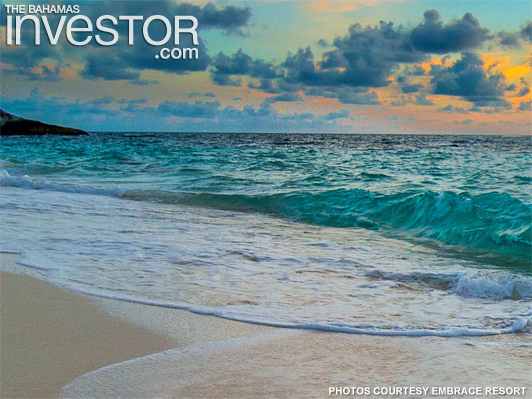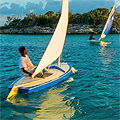| Published: Date: Updated: Author: |
The Bahamas Investor Magazine January 21, 2015 January 21, 2015 Catherine Morris |
Thanks in part to the growth of ecotourism and a greater awareness of environmental issues, sustainable tourism has gained ground in recent years, particularly for destinations such as The Bahamas, which relies heavily on its natural attributes. Making the most of its reputation as an untouched tropical idyll is Staniel Cay, a two-mile-long island nestled in the Exuma chain and home to around 100 people, most of whom rely on the tourism industry and its long-term sustainability for their livelihood.
According to the Bahamas National Trust (BNT), 80 per cent of visitors to the Exuma Cays come to experience nature. Staniel Cay’s numerous coral reefs teem with a wide variety of tropical marine life and the clarity of the water makes the surrounding shallow seas a Mecca for divers, boaters, fishermen and yachters–with the latter arriving year- round and staying an average of three weeks. One of the main attractions is Thunderball Grotto, a unique rock formation in the water. At low tide, visitors can swim through the grotto and view the intricate cave system where scenes from two James Bond movies were filmed.
Tourists also flock to see the cay’s terrestrial wildlife, the most notable of which are the wild pigs. Placed by locals on nearby Big Major’s Spot years ago, a small contingent
of swine adapted to the tropical conditions, living on the beach and happily swimming out to greet boats in search of scraps to eat. Feeding them has become a popular tourist attraction and visitors come from all over the world to see them. A short boat ride from Big Major’s Spot is Allen’s Cay, which is also a popular stop for visitors as it is home to critically endangered Bahamian rock iguanas.
“Staniel Cay is different. It is special,” says Nicole Ferguson, a native of the island who has worked in its hospitality industry for more than 20 years. “We have the pigs, the grotto, the iguanas. This is the place to come because there is lots to do. People cannot wait to come back. We have a lot of repeat visitors.”
One such returnee is Denise Wilkinson from the UK who recently enjoyed her third visit to the cay and says it is the island’s natural attributes that keep drawing her back. “It is such a beautiful place; it really is paradise. There’s nowhere else like it. The colour of the water, the beaches, the wildlife … it’s the kind of holiday I look forward to all year.”
Environmental protection
Figures from the BNT show that 16,665 people visited Thunderball Grotto between November 2012 and April 2013. With numbers such as these, it can be a challenge to strike the balance between allowing tourists to use and enjoy Staniel Cay’s resources and protecting them. Ferguson believes the most important aspect of sustainable tourism is conservation. She says many of Staniel Cay’s landmark sites and local flora and fauna are under threat and must be protected. “We need long-term management,” she says. “Sustainable tourism means preserving what we have now so it will still be here for our children and our grandchildren, and so tourists in the future will have something to see.”
Much of the area around Staniel Cay falls within the boundary of the Exuma Cays Land and Sea Park, which is managed by the BNT. This 455 sq km park was created in 1958 to protect the marine environment and establish a no-take, marine reserve. In January 2013, the BNT published a report that reviewed current sustainable tourism models for the Exuma Cays. Working from the results, the organization adopted a Tourism Optimization Management Model to focus on tourists, their interactions with the environment and how these could be improved. The BNT also established a Project Management Group for the cays that will consist of local stakeholders as well as representatives from the Ministry of Tourism, the Out Islands Promotion Board and the BNT. The trust says its goal is to create “healthy tourism businesses, healthy host communities, healthy environments and happy customers.”
Embracing sustainability
In this vein, Ferguson established EMBRACE, a boutique hotel located on Staniel Cay that aims to give visitors a uniquely Bahamian experience in an sustainable and eco- friendly environment. The resort takes its name from the Bahamian Family Islands of Exuma, Mayaguana, Bimini, Ragged Island, Andros, Cat Island and Eleuthera. Each of the property’s seven villas is decorated in a style that represents those islands, with the Bimini villa, for example, decorated with a boat motif and shades of blue. Ferguson says she chose this approach so that visitors could learn something about the different islands of the archipelago whilst enjoying a relaxing holiday. “We wanted to do something that was Bahamian and that included each island. By the time you leave, you know something about the history of The Bahamas.”
The resort, which at press time was forecast to open in December 2014, can accommodate up to 41 guests. Facilities include The Capital, a restaurant serving “upscale Bahamian and American” fare, a spa offering massages and beauty treatments and a gym. A meeting room that can seat up to 80 people is also available for functions such as weddings and business events.
Ferguson worked with international design firm OBMI’s Green Matters studio to develop a strategic sustainability plan for the resort. The plan includes several key energy- saving initiatives including: solar water heaters; US Environmental Protection Agency’s Energy Star approved products that meet international energy efficiency standards; low flow toilets to reduce water consumption; and a specialized system to remove grease and filter food waste from water in the restaurant. The resort also hopes to reduce its imported food bill with a vegetable garden, located behind the restaurant, so guests can sample fresh local produce. What the resort operators cannot grow themselves, they will try to procure from local vendors. “I find locals to help with whatever I’m planning,” says Ferguson. “I try to keep the money in the community instead of it flowing out. I use local flowers when we have bouquets for weddings and we will be using local food in the restaurant. We want to use as many Bahamian products as we can.”
Buying local is a major draw for modern-day travellers, who Ferguson believes are more socially conscious and environmentally aware than in the past. “People want more and they want a full-service operation, but sustainability is important to them.”
For tourists such as Wilkinson, being a responsible traveller means treating the destination and its community with care and respect. “The appeal of a destination such as Staniel Cay is how unspoilt it is—I want to help protect that and leave as small a footprint as possible,” she says. “It is definitely important to me to help the local community. I want to feel like my tourist dollar is doing some good.”










